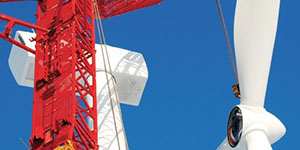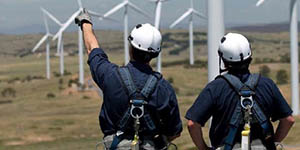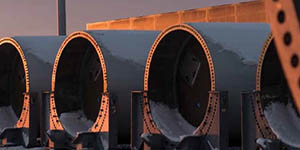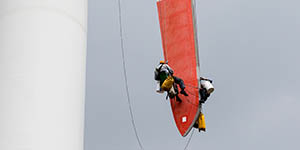Just as mining and new expansion drew calls for people to “go west” in America in the 19th century, the demand for clean energy is driving interest to a new western frontier — the Irish coast.
Ireland’s maritime area is more than seven times the size of its landmass, making it among the largest marine areas in the EU. And with an endless supply of strong Atlantic winds blowing into Ireland’s western coast, this area could prove pivotal to meeting the EU’s goal of generating 300 GW of offshore wind energy by 2050.
At the national level, Ireland aims to have 5 GW of offshore wind energy in development and be generating up to 80 percent of its electricity from renewable sources by 2030. And while more work and investments are needed, both the Irish government and industry are making strides toward realizing these goals to make the Emerald Isle a leader in green energy.

A Nimble all-of-government Approach
Any country attempting to incorporate offshore wind into its national energy strategy knows this is a complex, multi-decade endeavor.
Government bodies must be aligned. The energy grid must be updated and expanded. New skills must be identified and developed through education and upskilling. And industry must be involved at every step to drive market interest and innovation.
In this regard, Ireland’s smaller size may be an advantage.
In larger nations, slow-moving bureaucracies and divided political fractions can make finding agreement and achieving progress on large efforts like an offshore wind strategy a slog. But Ireland has embraced an all-of-government approach, with views aligned across departments.
The importance of collaboration across government departments and with investors and industry is stressed in Ireland’s offshore industrial wind strategy “Powering Prosperity.” “Powering Prosperity” outlines Ireland’s strategic vision to harness its vast offshore wind potential to drive economic growth, energy security, and climate action. The strategy sets ambitious targets scaling to 37 GW of green energy from offshore wind by 2050 — enough to exceed domestic electricity demand, support green energy production and exports, and decarbonize Ireland’s economy today, but also serve to attract the new industries of the future that require an abundant supply of affordable green electricity.

The strategy focuses on four core pillars:
- Offshore wind supply chains: It aims to build a world class domestic supply chain by supporting SMEs and start-ups and attracting foreign direct investment (FDI). Key actions include establishing an Offshore Wind Centre of Excellence (OWCE), expanding access to finance, and enhancing public procurement training.
- Research, development, and innovation (RD&I): Ireland will accelerate a cutting-edge RD&I ecosystem through collaboration between industry, academia, and government that has worked so well across Ireland’s other global leading sectors such as life sciences, international finance, and technology. Initiatives include developing a floating offshore wind demonstrator site, promoting regulatory sandboxes, and increasing investment in innovation through national and EU funding programs.
- Future demand and end uses: The strategy promotes the development of green-energy industrial parks and alternative energy uses such as hydrogen and sustainable aviation fuels. It supports co-locating renewable generation with large energy users such as data centers to maximize efficiency, and reduce curtailment and costs.
- Balanced regional economic development: It is intended for offshore wind to be a driver of regional growth, particularly in coastal areas. The strategy leverages regional enterprise plans and the Shannon Estuary Economic Taskforce to ensure widespread benefits, including job creation and infrastructure development.
Implementation of the strategy will be coordinated through the Offshore Wind Delivery Taskforce (OWDT), with oversight from multiple government departments, agencies, and industry stakeholders. Ultimately, “Powering Prosperity” envisions Ireland as a hub for offshore wind innovation, manufacturing, and services — contributing to EU climate goals, enhancing energy independence, and creating high-value jobs across the country.
In addition, key Irish state agencies also recently signed a memorandum of understanding that aims to align their efforts on the strategy and activities like attracting outside investments to build a robust offshore wind energy industrial base in Ireland.
Bringing offshore wind energy online isn’t a new effort for Ireland. Rather, it’s a continuation of the country’s existing renewable energy efforts.
Ireland is already home to 300 wind farms that generate more than 5 GW of energy, which provided about one-third of the country’s electricity last year. The developers of these projects bring valuable experience and skills to Ireland’s offshore wind energy strategy.

Opportunities for Industry
Ireland has understood from the start that private-sector involvement would be essential to realizing its offshore wind energy ambitions.
A domestic offshore wind energy industrial sector comprised of both multinational and home-grown companies, ranging from engineering companies to turbine manufacturers, will enable Ireland to create a resilient supply chain for its offshore wind energy needs and a pipeline of innovation for the still-emerging green energy sector. The build-out of this sector creates significant opportunities for industry in Ireland and beyond.
Northwestern Europe is home to some of the continent’s strongest offshore winds, which will help power the EU on its way to meeting its 300 GW wind-energy goal. By establishing operations in Ireland, industry can have a central hub to serve this larger need. Ireland is particularly well suited to the needs of U.S.-based multinational companies seeking to stake a claim in Europe’s green economy. It’s the only English-speaking country in the EU, and it has historical and cultural ties to the U.S. Ireland also has a business-friendly environment and number of inducements/incentives to spur and sustain the growth of its offshore wind energy sector.
For example, the Irish government offers research and feasibility grants, as well as tax incentives for R&D activity. And IDA Ireland, the government’s foreign direct investment arm, has facilitated the establishment of more than 50 green investments to date.
Ireland continues to increase its talent pipeline for the country’s growing offshore wind energy sector and the larger green economy. Higher level technology institutes in Ireland already provide training and skills development for the green-energy industry. And organizations like Skillnet Ireland are engaging industry to create talent frameworks and upskilling programs that address the need for green skills.
Powering an Energy Revolution
Offshore wind energy will be a major contributor to Europe’s transition to a cleaner energy model. It will also provide a new way to power industry — from energy-intensive data centers driven by the insatiable demand for electricity driven by the growth in AI to the many businesses with net-zero goals, to completely new industrial sectors establishing in Ireland to benefit from the potential vast quantities of affordable green energy — in Ireland and beyond.
Ireland isn’t content to merely participate in this energy transition — the country is eager to help lead it. And for investors and industry players in the green economy, this leadership isn’t just creating a new market, it’s creating a strategic opportunity.
























